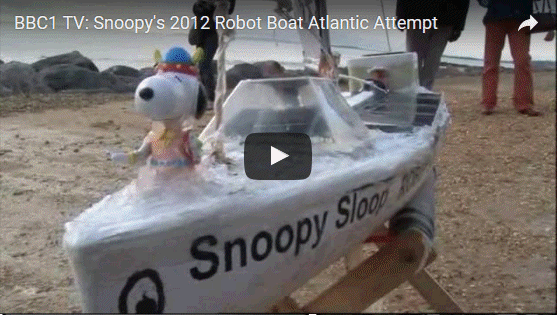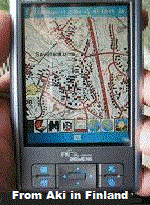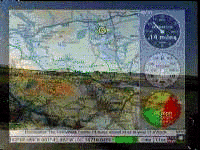
To see use of the translation flags, and translated subtitles on Youtube videos, Play Video Here . Videos only play from English pages.
![]()

Click on the Russian flag or
RUSSIAN to translate this page into Russian.

The time in UK in Winter is GMT (Universal Time); in Summer it's +1 hour British Summer Time (BST); On USA West Coast it's -8 hours;
In Kuybyshev, near Novosibirsk, Siberia, Russia it is +7 hours.
This Kuybyshev is about 4.3 hours car drive west of Novosibirsk.
Home .
About .
GPS .
Downloads .
Business .
Partners .
Contact .
Family .
AVL .
Links .
History .
AsOnTV .
Holidays .
Snoopy .
NHSCare.info .
Grumpy
![]()
Play the BBC TV video to introduce Robin and Snoopy, then click on a picture for Robin's Snoopy or Home or Pocket PC or AsOnTV or Grumpy pages.
Pictures say so much more than words.... Фотографии говорят так много больше, чем слова
What's the connection between Akalu and Aleksey's Sailing Saucer ?
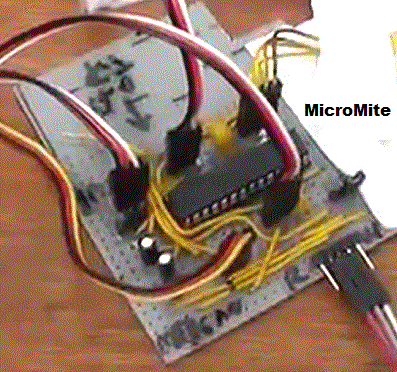 The answer is
Serendipity
, and the overlapping interests of Robin's old GPS Software friends, in 150 countries.
Robin's free
Pocket PC GPS Software
was exploited by Akalu, Tourism businesses, and it has a Robot Boat Autopilot.
The
MicroMite
is a tiny little chip which has the power of a PC.
This is due to the clever software inside, developed by a Grumpy Old Man in Perth Australia.
"Grumpy Old Man" means "Pensioner".
The answer is
Serendipity
, and the overlapping interests of Robin's old GPS Software friends, in 150 countries.
Robin's free
Pocket PC GPS Software
was exploited by Akalu, Tourism businesses, and it has a Robot Boat Autopilot.
The
MicroMite
is a tiny little chip which has the power of a PC.
This is due to the clever software inside, developed by a Grumpy Old Man in Perth Australia.
"Grumpy Old Man" means "Pensioner".
Most of the experts helping Robin are in this category: they have the knowledge, experience, and the time to "make things happen". They communicate by direct email and on various forums. e.g. the MicroMite Back Shed Forum . Also by commenting on Youtube videos. Automatic translation is important for us to communicate. Perhaps the most powerful are the automatic subtitles in Youtube videos - if only to entertain :-)
If Aleksey wants to get a good GPS Autopilot into his first protype Sailing Saucer Robot Boat quickly,
he could start with a Pocket PC and use what is free. If Team-Joker get the MicroMite working well, this will be easy for Aleksey
to re-program himself. e.g. sailing the boat on local lakes, and collaborating with his friends in Russia, Australia, China,
USA, UK, and anywhere in the World.
![]()


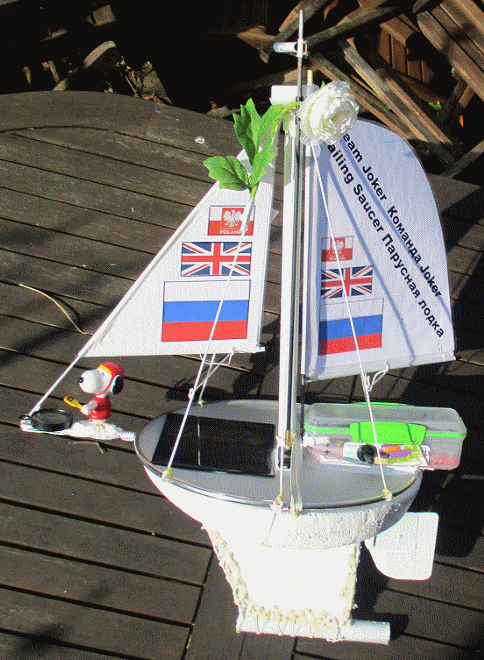
Aleksey's "Sailing Saucer" Robot Boat Blog
Updated at 1350 Z/GMT/UT ( 1450 BST ) on Wednesday 12th April 2017 UK Time
( Videos of Sailing Saucer without a keel, then with. Now bigger mainsail. Wind Vane Clutch. New Video ! )
( Click on pictures to enlarge them and/or see details )
Hi Guys ! This is "Aleksey's Sailing Saucer" page, set up in February 2017. It is based on his ideas about robot boats, shared with me and my Team-Joker friends on my Snoopy pages. Aleksey Urzhumov lives in Kuybyshev . Aleksey did live in Novosibirsk, the district capital of this area of Siberia in Russia.
This page may help Aleksey to communicate with others interested in the same things as himself : not just robot boats. He tells me that he has worked as a car mechanic, and our discussions show he is a passionate engineer.

 If you click on my friend Gary Carter, on the left, you can visit his web site.
Gary has been fixing our cars for many years, and shares other hobbies - like flying model helicopters.
The first Snoopy Robot boats were given to me by Gary.
They are still in my garage - you may see them below.
He will soon be testing his Pocket Pal, sent to me by Yilia in Shenzen, China.
If you click on my friend Gary Carter, on the left, you can visit his web site.
Gary has been fixing our cars for many years, and shares other hobbies - like flying model helicopters.
The first Snoopy Robot boats were given to me by Gary.
They are still in my garage - you may see them below.
He will soon be testing his Pocket Pal, sent to me by Yilia in Shenzen, China.
If you google "Aleksey Urzhumov", you will find prize-winning geography teacher with the same name, and not far from him. However, Aleksey assures me that they just has the same name. i.e. a "namesake". I'm sure the other Aleksey will be very interested, and may help our Aleksey with his robot boat. See those American boats launched by High School Students on my Toy Boat page ! :-)
I do not speak Russian, and rely on google translate for the Russian you see on this page. Aleksey tells me he does not speak English, but all our email communication is in English and he is using excellent translation software. Click on the Russian Flag to switch the English on this page to Russian.
Maybe some of you may want to take a holiday trip to Kuibyshev in Siberia, Russia ? Click on that image of Novosibirsk on the right, to access google information about the region. I was very impressed with the quality of housing and lovely parks in Kuibyshev, compared with where we are - that will surprise many of you, as it did me.
I wanted to add more to this page, before Alek and I made it public: it is now. I will want to contact some of my Russian friends, most in places like Moscow, who helped me many years ago, making my free GPS Software speak Russian and display cyrillic script. Those were the days before Google Translate ! I would also like to mention things that Alek and I discussed soon after he made contact in January. e.g. Global Warming and International Relations discussed on my Grumpy page. Visit my Home page to know about me. Anything we can all do to bring a little peace and understanding in the World can only be good.
 Click on that picture on the left for the old page
2008 to 2010.
Click on that picture on the left for the old page
2008 to 2010.
It contains valuable information on how Aleksey, or anyone in the World, can put together a Pocket PC based autopilot. It has the technical details of how we did it back in 2008.
Sometimes there are amazing and happy coincidences in life. e.g. June wanted to go to Wisley Gardens, and - as we entered the gate - we met my old workmate Brian and Norma. I was also using the opportunity to road test that new MicroMite computer.
Aleksey already knows of the project to test a new low cost chip from Australia called the MicroMite. It may be possible for me to run the Pocket PC autopilot software, last used in 2011, with much less work than our development of the low power Picaxe Autopilots, suitable for many months at sea, where solar power is needed. If the autopilot needs more power, to run something like an Arduino or Raspberry Pi, it may be very difficult to build a small boat - which is more able to sail anywhere.
Alexsey has made it clear that he does not want to build the boat himself: just give the plans to others. Maybe Aleksey's sailing boat friends could start with an iPAQ, and - if the MicroMite is found suitable - adopt that ?
I found that iPAQ 2008-2010 page, searching for Brian with me and Snoopy Sloop 4 ! :-)
![]()
I started this Blog with a few pictures, including taken of me in my garage, looking for materials for his "Sailing Saucer"
robot boat. Maybe he can start with my free Pocket PC based GPS Autopilot ?
Or course, not all of Snoopy's Pensioner Friends are Men. Hi Angela ! Stuart: no harm in you showing this to
anyone, but best not email the link to anyone. I don't want more emails coming in.
However, I'm sure Aleksey would love to chat with anyone on that
MicroMite Back Shed Forum
No harm in sending that, or showing guys what's on your screen.
You can always tease Aleksey about how warm it is.
Angela: Aleksey is young, handsome, and a qualified mechanical engineer like Stuart ;-)
![]()




![]()
Team Joker's first Sailing Saucer nears completion; A short video of Friday 10th March - then Wednesday 12th April ! :-)
1100z on Thursday 9th March 2017: Robin's Mk1 Sailing Saucer is ready for first water tests. Mk1 uses conventional rudder steering, and can exploit Snoopy's existing Autopilots, including old Pocket PC GPSSppc and later Picaxe based Autopilots. Mk2 will use Aleksey's ideas for wind vane steering - already in old GPSSppc Autopilot. Work to reach this stage, was done while waiting for paramedics. Details in English, are in the screen image Jack is OK. Robin's plans for today include: water tests of Sailing Saucer Mk1; A quick visit to see Jack; Shopping for Mk2 bits and maybe visit Bray Lake with Mk1. A longer visit to see Eric late this afternoon. If there is time, of course :-)
2125z update: One of June's plastic garden water tubs was perfect to check how the boat sits in the water.
The solar panel meant it was a bit low at the front, with the bottle tops near the water.
Very little weight is needed at the back to raise the front to encourage water planing.
Installation of a servo with linkage to the rudder was simple, and
Wiring of the solar panel through to power monitor points and plugs to digital radio control is going well.
An autopilot can simply plug in, instead of the radio control receiver. But simple tests first.
Robin's attempt at an engineering diagram of the Sailing Saucer. This is followed by Aleksey's drawings.
First "Engineering Concept" from Aleksey, that matches Robin's Sailing Saucer Mk1:
e.g. leading edge of Saucer to encourage water planing; very shallow "keel" to guide, but not to balance.
e.g. two polystyrene floats, and VERY light plastic or brass strip before rudder.
Maybe wired to 0V of electronics, providing a ground plane for GPS, Sat Comms, remote GSM cameras, etc.
Yes Aleksey: it was I who invented the Windmill Boat in the 1970s, and took money from my fellow NATO scientists :-)
See my
Sir John Maniello
Page, for details of my NATO work and the day of Samantha's birth.
No time to have breakfast: June & Samantha are back from Tennis; Soon off to take Jack out for our Tesco Big Shop in Bracknell Martin's Heron :-)
Aleksey's first Engineering Drawing public release ....

Aleksey's drawing received on 5th March showing his concept for wind vane steering.
Well Done Aleksey ! This concept is completely compatible with our original 360 degree wind vane autopilot iPAQ software.
After tests of my Sailing Saucer Mk1, I will probably make a Mk2 - adopting this idea, and the same 360 degree servo
from the old Boats. THE BIG DIFFERENCE is that the steering is done directly on the boat, rather than through a mechanically
linked rudder. But one step at a time: "Change a Little, Test a Lot" - as an experieced work mate from EASAMS then STC once told me ;-)

Aleksey said, with this drawing:
"Hi Robin. Here's another design for publication.
Bad, that it requires two servo drive. One for the keel and another for the sail.
This significantly reduces the survivability of the boat. I was going to make such boat.
This last century, but nevertheless it works fine".
I guess by "this last century", Aleksey means, "Since 2000". His Russian->English translation software is fantastic.

On Thursday 9th March, Aleksey said this, with another drawing:
" Hi Robin. I understand, why you want to use the rod inside the mast. You want to use the effect of torsional elasticity of the rod as the damper. The picture sq1 confirms my understanding. It is an excellent idea to use a torsional elasticity. I don't think, the strong wind will be able to wring the neck of a such wind vane. You are doing all right. A strong wind can topple the mighty oak, but this wind cannot break the flexible stem of barley. Bionics is a very useful science. I am going to think over the scheme of the "Servo ---> Wind vane". Perhaps, this scheme will work well on small boats with a size of 1-3 meters.
I have thought now, that if to use this kind of wind vane, the boat can sail backwards for a few seconds. This can mean, that a straight keel (no sweep), probably will be cleaned of debris. But, I am not quite sure in it. A straight keel (centerboard) is much easier in the making, than another type of keel, I am about it. I assume, that the area ratio of the sails, must be other than, that shown on the pic var2. This can be found experimentally, or need to use more simple sail. I want to say, that the sail must have a small destabilizing torque. This will allow to apply a small wind vane. It is a pity, that I have no the wind tunnel.
No doubt, Dick is master.
Aleksey"
08.03.2017 23:29, Robin Lovelock пишет:
> Thanks Aleksey. I have updated your page on www.gpss.co.uk/alek.htm
> You may also like the new video of Dick flying his Drone on www.gpss.co.uk/amra.htm
> I hope to finish Sailing Saucer #1 very soon, and today I got material for #2 that will use a 360 degree servo and rotate rod inside mast.
> I am lucky that I used big white plastic tube - plenty of room for a carbon fibre tube inside, for Servo ---> Wind van.
> Das Vidanya :-)
> Robin
> www.gpss.co.uk
> p.s. later today I hope there will be a mugshot of Enrico on www.gpss.co.uk/holiday.htm
On Friday 10th March 2017, Aleksey said:
"Good Morning Robin. There is another problem. This is a whirlwind. Picture qw1.
A special clutch is needed (required), which must be between the worm drive and wind vane. In ideally, this clutch must remember (keep) the previous position of the wind vane relative to the worm drive, after an attack of the whirlwind. This clutch will replace a torsional damper, which is based on an elasticity. You see, this damper is not suitable for all cases, and it works not very well, at small angles and at a very big angles.
Alexey.
 Good late evening Aleksey. I also like the idea of a clutch - but to be used differently. No need for a steping motor or 360 degree servo. My rudder autopilot would disengage the clutch, use the rudder to put the boat onto the correct course, then engage the clutch for wind vane steering - and less power loss for GPS, servo, etc :-)
But that is Sailing Saucer Mk2. First I want to test Mk1.
But I have the bits for Mk2 - it is just the clutch. I would use a normal servo to operate it, with a spring to hold it engaged.
i.e. the servo is only used a few seconds, when setting the angle by letting the vane blow downwind.
Good late evening Aleksey. I also like the idea of a clutch - but to be used differently. No need for a steping motor or 360 degree servo. My rudder autopilot would disengage the clutch, use the rudder to put the boat onto the correct course, then engage the clutch for wind vane steering - and less power loss for GPS, servo, etc :-)
But that is Sailing Saucer Mk2. First I want to test Mk1.
But I have the bits for Mk2 - it is just the clutch. I would use a normal servo to operate it, with a spring to hold it engaged.
i.e. the servo is only used a few seconds, when setting the angle by letting the vane blow downwind.
Sorry for this late reply Aleksey: it has been a very busy day, including Jack being taken to hospital, but I am sure he will be home soon - maybe tonight.
2245 Saturday 11th March 2017: Good Late Evening again Aleksey. I just wanted you to see this photo above with Sailing Saucer Mk1 ready for radio control sailing tests, after fitting the water proof on/off switch. You also see other things in the picture, like the new remote 3G GPS Cameras from my friend Sophia in Shenzhen. It has been another busy day, with us collecting Jack from hospital. He is happy at home, watching the TV news. I am about to join June, with my glass of wine, watching a late film. I wonder if she would enjoy a trip to Bray Lake tomorrow ? ;-)
On Sunday 12th March 2017, Aleksey said:
"Hi Robin. I am sorry for late reply. If to make a model of a Sailing Saucer Mk2 (SSMk2) as an experimental model, for the checking of the scheme "Servo ---> Wind vane" on Bray Lake, then I think, it is not so important, what type of the servo, normal servo, or worm drive servo use for the testing. But, if to make naval variant of the Sailing Saucer, in my opinion, the easiest and reliable variant of the servo is just a "stepping motor&worm drive" (picture qe2). If a stepping motor will consume a little electric energy, then it would be better to apply a simple scheme "stepping motor&worm drive". Regarding the sea, than the mechanism is simpler, then better. I think, you will agree with me in it.
I wanted to ask you, will a compass be used for the Sailing Saucer, and how often is better to control the course of the Sailing Saucer at the sea? What is an interval of time the best of all for this?
The Sailing Saucer Mk1 has a large area of the sail.
Aleksey
11.03.2017 4:37, Robin Lovelock пишет:
> Hi Aleksey. Sorry for this very late reply, but my friends know it has been a long day.
> But after lots of sleep, I look forward to having fun with Sailing Saucer Mk1 !
etc, etc.
No Problem Aleksey. Only time zones of 7 hours seperate us. I do not think too far ahead with the detailed design,
until I have done a lot of prototyping, testing, and research - including into off the shelf product.
Sailing Saucer Mk1 is now ready for sailing tests, under radio control. If it behaves OK, then it takes only a few minutes
to replace the radio control receiver by a Picaxe autopilot. Then we will do our first Bray Lake Test.
This will probably be with the old Autopilot, without a compass. But again, it will only take a few minutes
to swap this for a Picaxe Autopilot that has a compass. After tests with Sailing Saucer Mk1, I will be ready
to start tests of Sailing Saucer Mk2 - with your wind vane idea. The simplest solution - and the lest cost - is
that 360 degree servo. It is simpler to buy than to build, and the Pocket PC AutoPilot already supports it
- see our very first successful Bray Lake Test - it was with a WindVane. But your idea is simpler - the vane
turning the boat directly. I am thinking that the interval of time for setting the vane angle will be dependent
on range to the next waypoint. i.e. it could be tens of seconds on Bray Lake, but many minutes, out at sea.
But one step at a time :-)
Robin
2015z Sunday 12th March 2017.
 at 1803z UK time on Monday 13th March 2013 ( ~ 0100 Tuesday in Siberia ), Aleksey said:
at 1803z UK time on Monday 13th March 2013 ( ~ 0100 Tuesday in Siberia ), Aleksey said:
Hi Robin.
"I also like the idea of a clutch - but to be used differently. No need for a steping motor or 360 degree servo.
My rudder autopilot would disengage the clutch, use the rudder to put the boat onto the correct course,
then engage the clutch for wind vane steering - and less power loss for GPS, servo, etc :-)
But that is Sailing Saucer Mk2. First I want to test Mk1. But I have the bits for Mk2 - it is just the clutch.
I would use a normal servo to operate it, with a spring to hold it engaged. i.e. the servo is only used a few seconds,
when setting the angle by letting the vane blow downwind."
If the autopilot engages the clutch, when the angle of attack of the wind vane is 0 degrees, the boat will turn to the right, or to the left, by the angle A' of 10-15 degrees, after an engaging of the clutch. The angle A' is a normal angle of attack of the wind vane. But, that is else a half of the trouble. The mass of the wind vane is a small, and if the wind vane is not fixed on the boat, the wind vane can make angles of +/- 10~40 to the right, or to the left, due the turbulence. This means, that can be a big mistake in the working of the scheme, which you propose. If the wind vane will be connected all time, through the worm drive, then the error in an installing of the boat onto a new course will be a very small. Because, the boat has a large moment of an inertia, and the wind vane will show an average direction of the wind in this case. Then, it will be easy to write a good program for the scheme of "stepping motor----->worm drive---->wind vane", and this program will not require a compass. Buy the way, about the compass. Do the indications of the compass, which you use, depend on the inclination of the compass? I mean, strong pitching on the sea. Oops! If the wind vane is not fixed, the angle of the wind vane will not only depend on direction of the wind. It will be visible to the naked eye, when there are a big swell and a weak wind on the sea. This can give bigger error in the installing of the boat on a course. Therefore, I suggest you to use this scheme: "stepping motor----->worm drive---->wind vane".
"I do not think too far ahead with the detailed design, until I have done a lot of prototyping, testing, and research - including into off the shelf product".
Will you use a wind tunnel to configure the system "Sail<---->wind vane" for the Sailing Saucer Mk2?
I am sorry for my English.
Aleksey.
 Your English through translation is excellent Aleksey. I forgot to say earlier that I prefer not to use any steel in my robot boats.
I prefer plastic, or perhaps brass. There are several reasons for this: steel does not like salt water; magnetic compasses do not like steel.
In answer to your question, "will I use a wind tunnel ?": No, I will use the real weather, on places like Bray Lake, including
in gale force winds.
Your English through translation is excellent Aleksey. I forgot to say earlier that I prefer not to use any steel in my robot boats.
I prefer plastic, or perhaps brass. There are several reasons for this: steel does not like salt water; magnetic compasses do not like steel.
In answer to your question, "will I use a wind tunnel ?": No, I will use the real weather, on places like Bray Lake, including
in gale force winds.
Today there were other priorities, including June's father Jack, 97, having a stroke, but he is in a good hospital: Frimley Park Military Hospital, and I am optimistic for his future. However, despite this, I had a few minutes to make good progress on Sailing Saucer Mk1. It already was ready for tests on Bray Lake, with Radio Control, then a Pocket PC or Picaxe AutoPilot, with conventional rudder guidance. However, it now also has the simple 360 degree servo, which took a few minutes to fit - much less than the time to construct a stepper motor equivalent. The Compass we use - if I use it - is tilt compensated. You can find details on my design pages. This vane servo is already connected to a radio control channel, so I am also ready for tests of your wind vane steering idea. As always, the time is taken by the testing, not construction. I have simple ideas for the clutch, but it will be simpler to make and show pictures and video than to describe in words. Depending on other things like Jack, there maybe more news and pictures tomorrow.
I saw the news earlier: it seems New York will soon be experiencing some of your Siberian weather :-)
Alexsey: Thanks for sharing your ideas on "Sailing Saucer" openly, with my Grumpy Old Friends around the World. If you print this in Russian, you can show your friends and family.
On Tuesday 14/03/2017 08:09, (UK) Aleksey wrote:
Hi Robin. I'm sorry about what happened to Jack. I understand your condition and the condition of your loved ones,
and how is hard to you now. I worry together with you. Jake's idea to set a white rose on the mast of the boat is a very good.
A white rose on the mast carries a large symbolic value. If the boat perish in the waves, then it will be a great reproach to those,
who spends a great money on weapons, and doesn't want to spend money on the consolidation of peace on the Earth,
and in particular on the study of the mysteries of the nature.
If you can, pass "Hi" to Jack from me, please.
Aleksey.
( Robin replied, CCing several of their extended Team-Joker friends )
 Here is that video that I hoped to have ready: it shows you that Sailing Saucer Mk1 now has a rudder AND a wind vane.
Now I am looking forward to testing it somewhere like Bray Lake. There is also good news about Jack. I got an email
from June at Frimley Park Military Hospital to say, "They are giving him antibiotics for the pneumonia as well as the urinary infection.
He has also seen a speech therapist and a physio this morning".
Here is that video that I hoped to have ready: it shows you that Sailing Saucer Mk1 now has a rudder AND a wind vane.
Now I am looking forward to testing it somewhere like Bray Lake. There is also good news about Jack. I got an email
from June at Frimley Park Military Hospital to say, "They are giving him antibiotics for the pneumonia as well as the urinary infection.
He has also seen a speech therapist and a physio this morning".
Aleksey replied: Hi Robin. I hope, Jack will be better. While, the person is breathing, there is a hope for the healing. Spiro spero - while we breathe, we hope. I hope, Jack doesn't have a strong suffering. The worst thing for people is a pain and a suffering. Death is not so terrible, as the misery and suffering. There was no need to let Jack watch the news on TV set. Now, almost all of the news on TV are negative. Old people can be upset over news, and they can have a stroke, after a watching TV. I don't watch TV for many years, and don't read news on the Internet. Because, my mood is worse, after I watch and read the news. I only read Wikipedia and books, and I don't regret, that I don't know, what's going on in the world now. It seems to, I understand, why a mountain monks are so happy.
I see, you've decided not to build Sailing Saucer Mk2, and just upgrade Sailing Saucer Mk1 to Sailing Saucer Mk2. From the beginning, I suggested you to apply wind vane on Sailing Saucer Mk1. If you did not had a desire to use a bermuda sail on Sailing Saucer, then I would not start thinking about this wind vane. You see, how everything is interconnected.
It's a good, that the boat is heavy. Than more the mass of the boat, than better wind vane will work. You know, that wind vanes are used on a big boats and yachts. And these wind vanes keep (hold) boats on a course well, even, when the wind are very strong. Because, this kind of wind vane has a large mass and the height of the vane. Therefore, if a little boat has a big wind vane, we have the right to expect, that this little boat will be staying on a course, as well, as a yacht will be. But, it's just a theory.. It is interesting to check this theory in a practice. I hope, you can check this theory. I guess, if the boat with this kind of wind vane has a mass of 15-20 kg, then such boat will stay on a course well, and it will be able to cross the Ocean.
..... etc.
Robin's response on 14 March 2017 included: ...
Yes, I know what you mean about bad news on TV - tonight it is all Africa bad news.
But our depression in seeing bad news on TV is small compared with those people who suffer.
You are the important part of this Team-Joker project - it may help bring a little peace and understanding.
At least we can say that we tried.
p.s. Paul, if you email to Aleksey, try and avoid spelling errors - he uses excellent translation software.
Hi Aleksey: just two pictures before you go to bed: 1) me having a relaxed lunch. 2) testing extended floats with frogs our pond :-)
 On 16/03/2017 07:19, Aleksey wrote:
Good morning Robin. I well understand your idea. But, one question confuses me. What to do,
if the boat is flipped due a strong winds, or due a big wave?
I guess, only a heavy keel will be able to avoid this situation. However, the boat, which has a massive keel,
will have a glisser mode with hard. And, if we use a little sail (the sail for a storm) on the boat,
the boat will not be able to float like a surfer. I think, we should not afraid of, if Sailing Saucer will have a speed less,
than normal boats. It is enough to have a good wind at the beginning of the travel.
The boat can overcome any tidal and current and go far out to sea, if a good wind will be.
There is almost always a good wind, away from the shore (coast).
It seems to me, the main feature (property) of an autonomous boat must be its reliability,
or survivability, rather not its speed. Just to need a very durable and a reliable boat for successful autonomous travel.
I may be wrong. It's just my opinion. I'm not against various experiments.
On 16/03/2017 07:19, Aleksey wrote:
Good morning Robin. I well understand your idea. But, one question confuses me. What to do,
if the boat is flipped due a strong winds, or due a big wave?
I guess, only a heavy keel will be able to avoid this situation. However, the boat, which has a massive keel,
will have a glisser mode with hard. And, if we use a little sail (the sail for a storm) on the boat,
the boat will not be able to float like a surfer. I think, we should not afraid of, if Sailing Saucer will have a speed less,
than normal boats. It is enough to have a good wind at the beginning of the travel.
The boat can overcome any tidal and current and go far out to sea, if a good wind will be.
There is almost always a good wind, away from the shore (coast).
It seems to me, the main feature (property) of an autonomous boat must be its reliability,
or survivability, rather not its speed. Just to need a very durable and a reliable boat for successful autonomous travel.
I may be wrong. It's just my opinion. I'm not against various experiments.
![]()
 Robin's reply on On 16/03/2017 at 1504 included:
Good Morning Aleksey. An alternative to a heavy keel is to use one of Dick's polystyrene balls at the top of the mast.
I agree with you, that for the Atlantic Challenge, reliability and survivability is the key.
Most of the other guys think that speed is important - if your crazy sailing saucer works, it will amaze them :-)
The MicroMite uses little power, like the Picaxe. The importance is that it is also very easy to program.
Typical power drain from the 5v supply is: GPS 50mA, Servo 15mA, Picaxe or MicroMite computer < 20mA.
With a Wind Vane, and power switching of GPS, Servo, Compass, and sleep mode on computer --> less than 20mA average.
The MicroMite page is what I must work on today (
www.gpss.co.uk/micromit.htm
) .....
News is good about Jack ....
I made a very important temporary change this morning, to the bottom of my "Home" page
www.GPSS.co.uk
.
Most of my friends will not understand, but I have friends who will understand, in many countries, in the military.
All modern armies have evolved to be organised in similar ways, over the centuries - it was survival of the fittest.
One of my friends was involved, many years ago, in the details of how Russian and NATO troops would fight on the same side.
I saw the same during visits to Egypt in the early 1980s, where there had been years of Russian military collaboration.
All a matter of procedures used for communications. On military maps NATO show the enemy red - that might change :-)
Robin's reply on On 16/03/2017 at 1504 included:
Good Morning Aleksey. An alternative to a heavy keel is to use one of Dick's polystyrene balls at the top of the mast.
I agree with you, that for the Atlantic Challenge, reliability and survivability is the key.
Most of the other guys think that speed is important - if your crazy sailing saucer works, it will amaze them :-)
The MicroMite uses little power, like the Picaxe. The importance is that it is also very easy to program.
Typical power drain from the 5v supply is: GPS 50mA, Servo 15mA, Picaxe or MicroMite computer < 20mA.
With a Wind Vane, and power switching of GPS, Servo, Compass, and sleep mode on computer --> less than 20mA average.
The MicroMite page is what I must work on today (
www.gpss.co.uk/micromit.htm
) .....
News is good about Jack ....
I made a very important temporary change this morning, to the bottom of my "Home" page
www.GPSS.co.uk
.
Most of my friends will not understand, but I have friends who will understand, in many countries, in the military.
All modern armies have evolved to be organised in similar ways, over the centuries - it was survival of the fittest.
One of my friends was involved, many years ago, in the details of how Russian and NATO troops would fight on the same side.
I saw the same during visits to Egypt in the early 1980s, where there had been years of Russian military collaboration.
All a matter of procedures used for communications. On military maps NATO show the enemy red - that might change :-)
![]()
 Aleksey Replied:
To tell the truth, your assumption about, what Sailing saucer can plane on the water like a surf-boarder, really have intrigued me. Yesterday, I have found out, that there are other unusual boards for windsurfing.
These boards are a very wide. It was a big surprise for me. Probably, you known, that there are this kind of boards. I believe, that it is possible to create a robot boat, that can float like a formula windsurfing. I am going to think about the sail, which can be used on this kind of boat. It seems to me, that it is possible to find a more elegant solution, than Dick's polystyrene balls.
How is Jack?
Aleksey.
Aleksey Replied:
To tell the truth, your assumption about, what Sailing saucer can plane on the water like a surf-boarder, really have intrigued me. Yesterday, I have found out, that there are other unusual boards for windsurfing.
These boards are a very wide. It was a big surprise for me. Probably, you known, that there are this kind of boards. I believe, that it is possible to create a robot boat, that can float like a formula windsurfing. I am going to think about the sail, which can be used on this kind of boat. It seems to me, that it is possible to find a more elegant solution, than Dick's polystyrene balls.
How is Jack?
Aleksey.
![]()
from Robin on Tuesday 21st March 2017: Hi Aleksey ! I filled up June's swimming pool yesterday, and today Sailing Saucer Mk1 had a sail :-)
 On 22nd March 2017 Aleksey replied:
Hi Robin. You're right, we need more stable wind for the qualitative tests. The spring equinox was, yesterday. I am guessing, a strong and a steady winds can be at your places, at this time of year. This time is the best time to test unusual boats. Do not miss the chance.
I agree with you, sailing saucer floats better without the plastic bottle. But, my models of sailing saucer floated faster, because models were a very light, and I have used other kinds of sails. One of them is shown at the picture pic22. A strong wind can lift the boat out of the water, if to use this sail. I saw it. However, it will already be a flying saucer hahahaha... If to make an inflatable sail with valves, like a parafoil https://en.wikipedia.org/wiki/Parafoil, it can replace Dick's polystyrene balls. But, I never did so. I have found out about a parafoil later. If to make the offset center of a gravity relative to the center of the sailing saucer, then the boat will strive to has a normal position, after the boat is turned over.
Aleksey.
On 22nd March 2017 Aleksey replied:
Hi Robin. You're right, we need more stable wind for the qualitative tests. The spring equinox was, yesterday. I am guessing, a strong and a steady winds can be at your places, at this time of year. This time is the best time to test unusual boats. Do not miss the chance.
I agree with you, sailing saucer floats better without the plastic bottle. But, my models of sailing saucer floated faster, because models were a very light, and I have used other kinds of sails. One of them is shown at the picture pic22. A strong wind can lift the boat out of the water, if to use this sail. I saw it. However, it will already be a flying saucer hahahaha... If to make an inflatable sail with valves, like a parafoil https://en.wikipedia.org/wiki/Parafoil, it can replace Dick's polystyrene balls. But, I never did so. I have found out about a parafoil later. If to make the offset center of a gravity relative to the center of the sailing saucer, then the boat will strive to has a normal position, after the boat is turned over.
Aleksey.

On Saturday 25th March 2017 Robin and June visited Bray Lake for a radio control Sailing Saucer test .... Aleksey was right - it DOES need a keel ! Now added and tested ! :-)



![]() Monday 27th March 2017: we now have a slightly bigger mainsail on Sailing Saucer Mk1,
and the keel has been strengthened with Gorilla Glue, so it does not flop about so much :-)
Monday 27th March 2017: we now have a slightly bigger mainsail on Sailing Saucer Mk1,
and the keel has been strengthened with Gorilla Glue, so it does not flop about so much :-)




![]()
Saturday 1st April 2017: Today's email conversation with Aleksey caused me to think about a Wind Vane Clutch.
This is from my email ...
"I can see that Sailing Saucer Mk1 may soon have the capability of Mk2 - with very minor changes ! :-)
Many years before Lego toys, in England we had Meccano. Materials were brass instead of plastic.
I have a box of Meccano bits used in my early robot boat experiments.
That gear wheel looked ideal - I simply drilled out the hole to 5mm and it fits on the carbon fibre wind vane shaft.
I can unscrew the fitting onto the 360 degree wind vane servo, and the shaft is free to rotate.
My idea is to use something like stainless steel wire, or the brass rod in the photo, to engage with the gear teeth.
A spring to hold it in, could engage the clutch ON.
A servo could pull the wire away from the teeth, to switch the clutch OFF.
The wind vane can then rotate freely, to the downwind position.
", ( before the clutch is switched ON again, resulting in wind vane steering, after using the Autopilot and rudder,
to steer the boat into the correct direction ).
I sent Aleksey the middle photo, but soon had found a good place, the other side of the mast,
for the new Clutch servo.
Sunday 2nd April: this new picture on the right shows the completed prototype vane clutch mechanism.
Our next Sailing Saucer test on Bray Lake can test how well the boat sails with normal rudder steering, and also wind vane steering, using the clutch. See video at top ! :-)
![]()
( If you do not see the visits on maps below, try clicking on a translation flag )
![]()
( End of the Blog on Aleksey's Sailing Saucer page www.gpss.co.uk/alek.htm )
![]()
![]()
![]()
visits to this page counted by
Web Counter
since 22nd February 2017. Not all are counted, and positions may be inaccurate. See end of
Snoopy
page for details.
© 1991-2017 Robin Lovelock and Aleksey Urzhumov ( Alek in contact with Robin and extended Team-Joker ).

